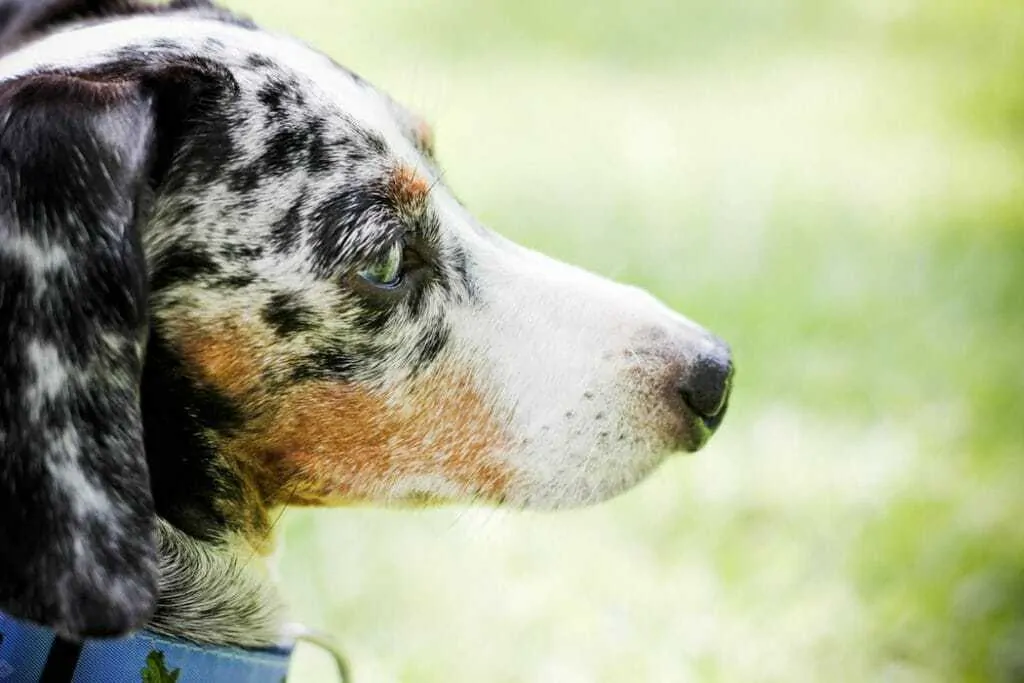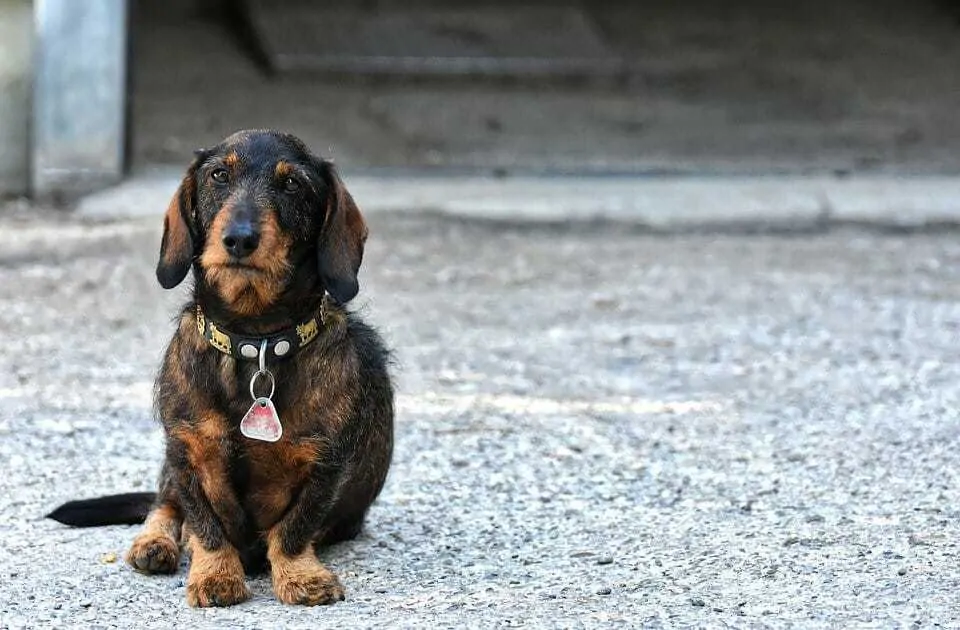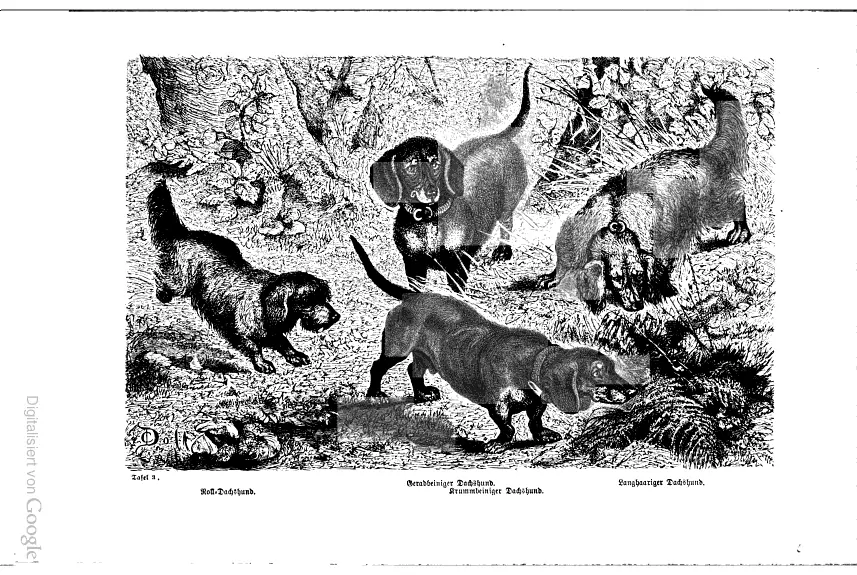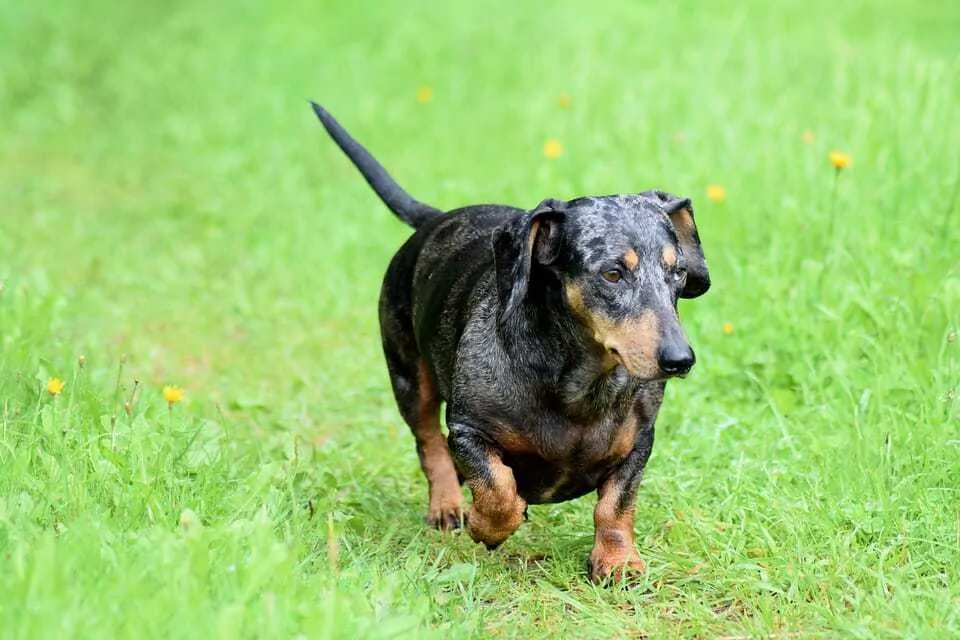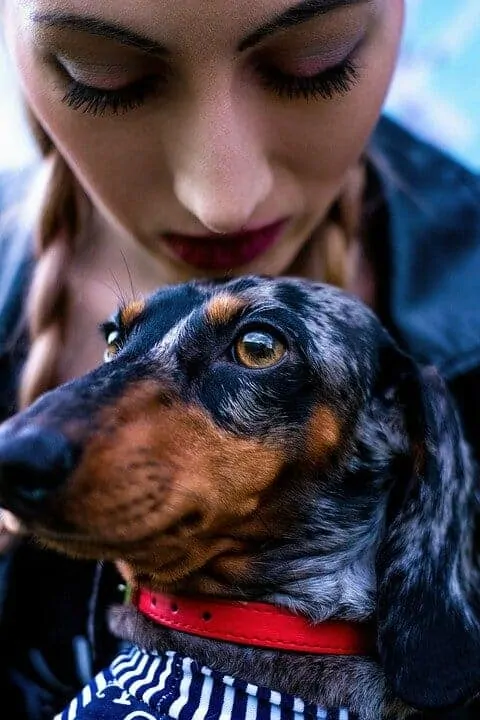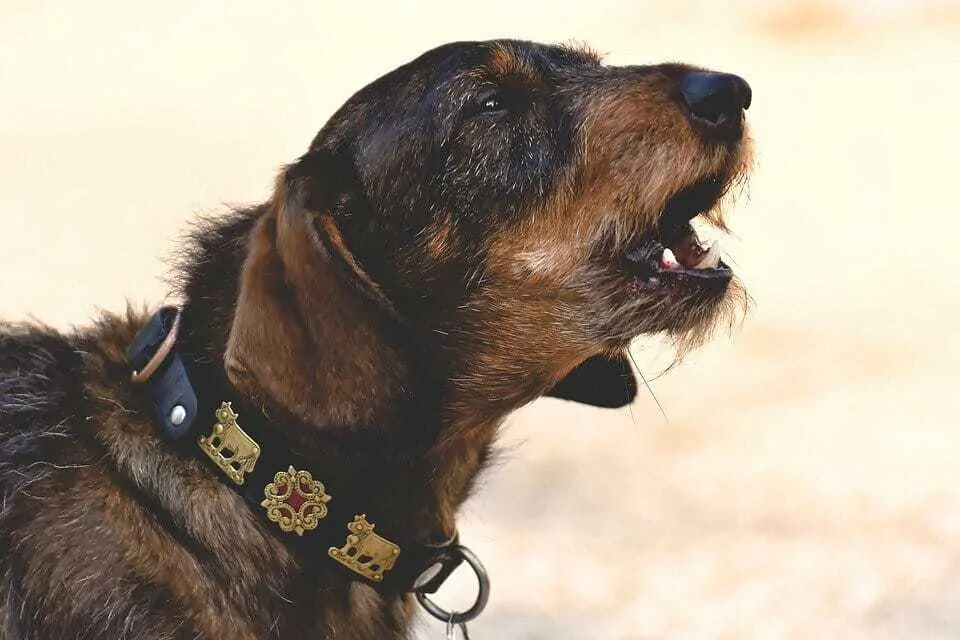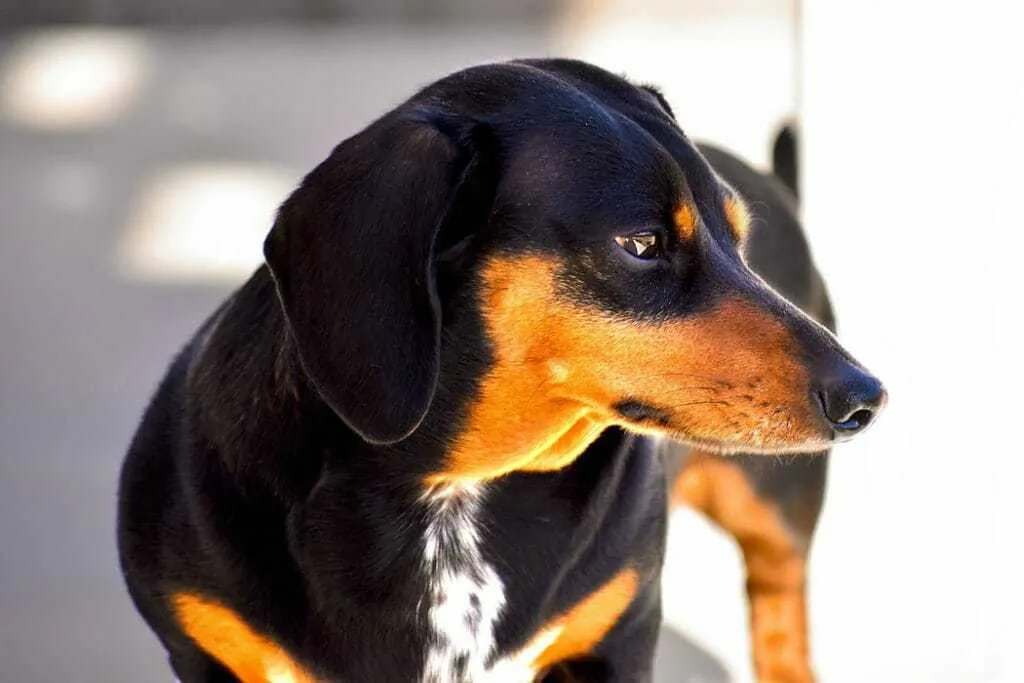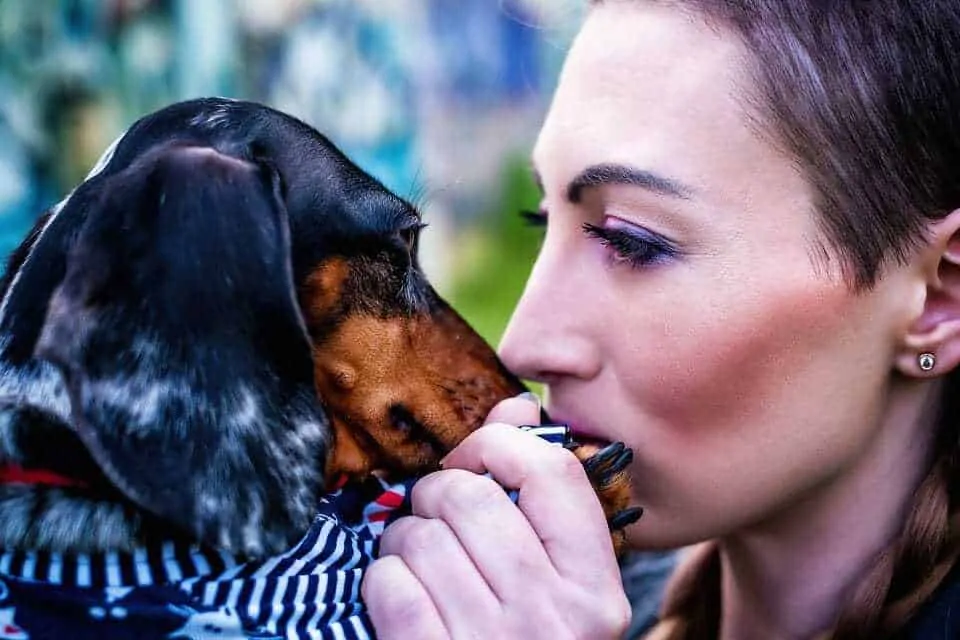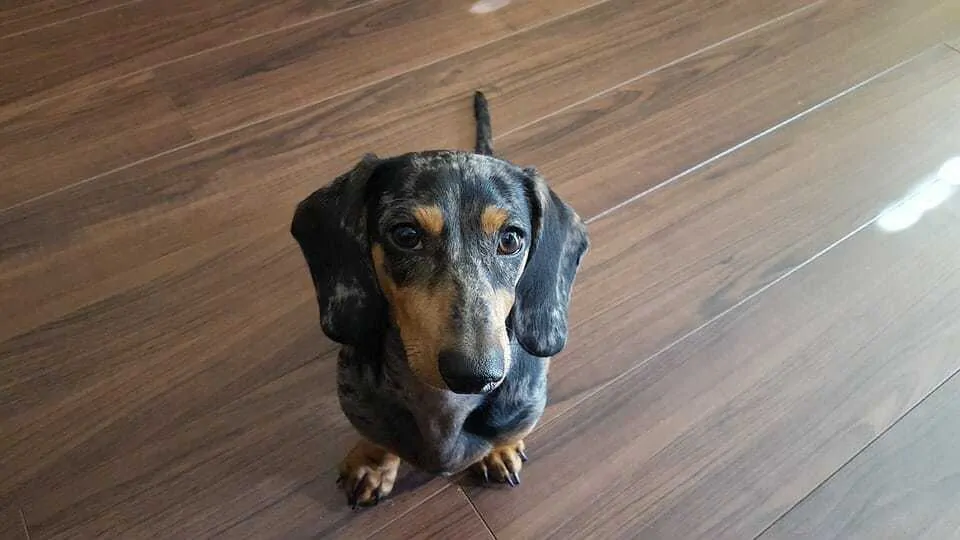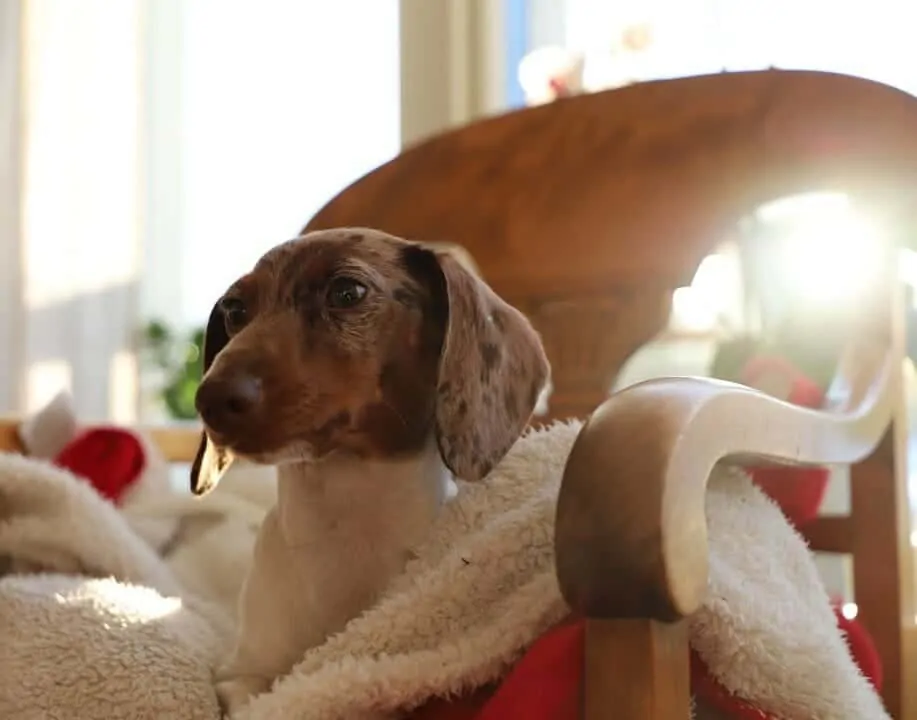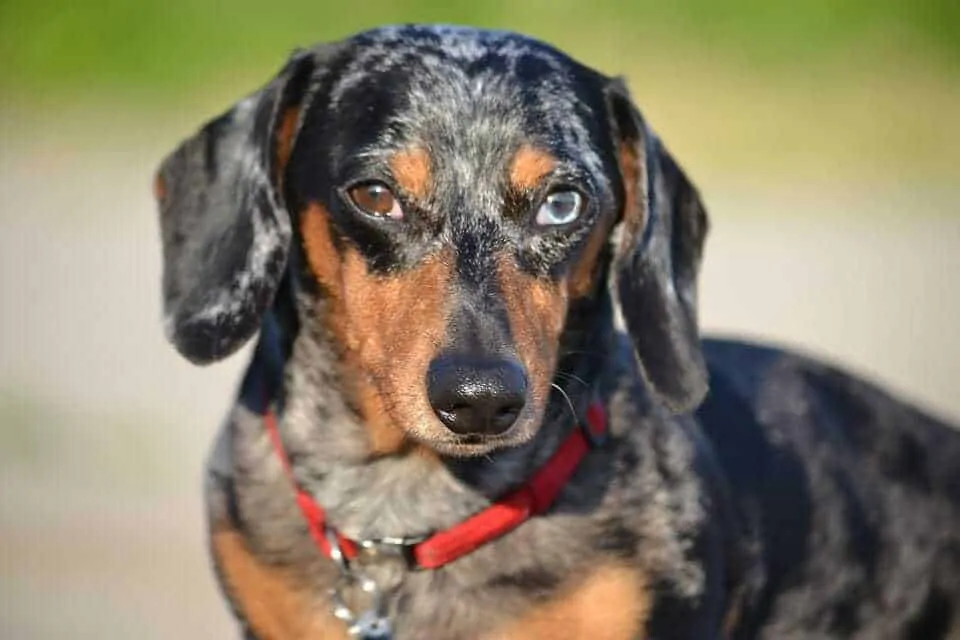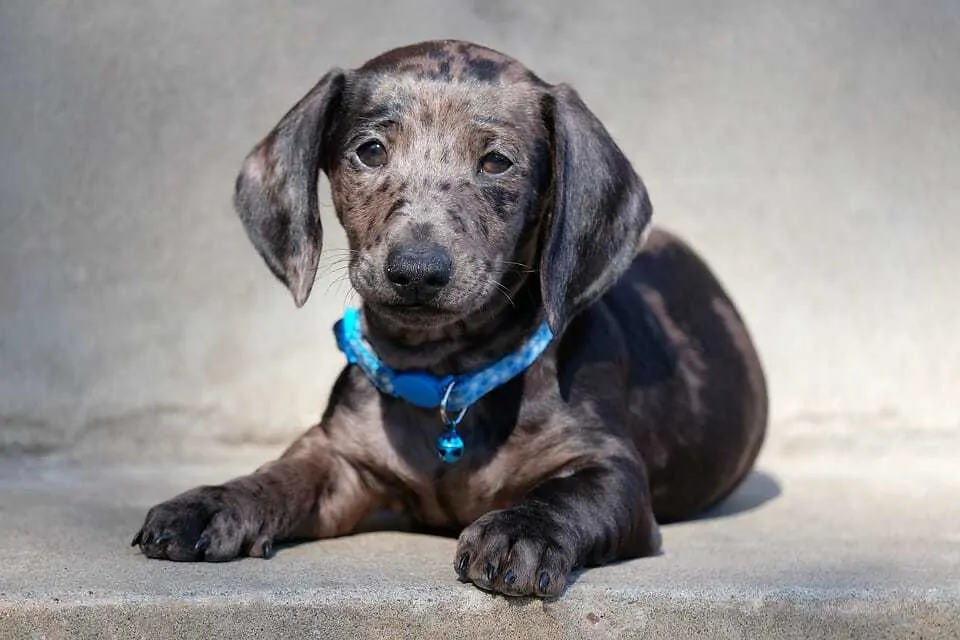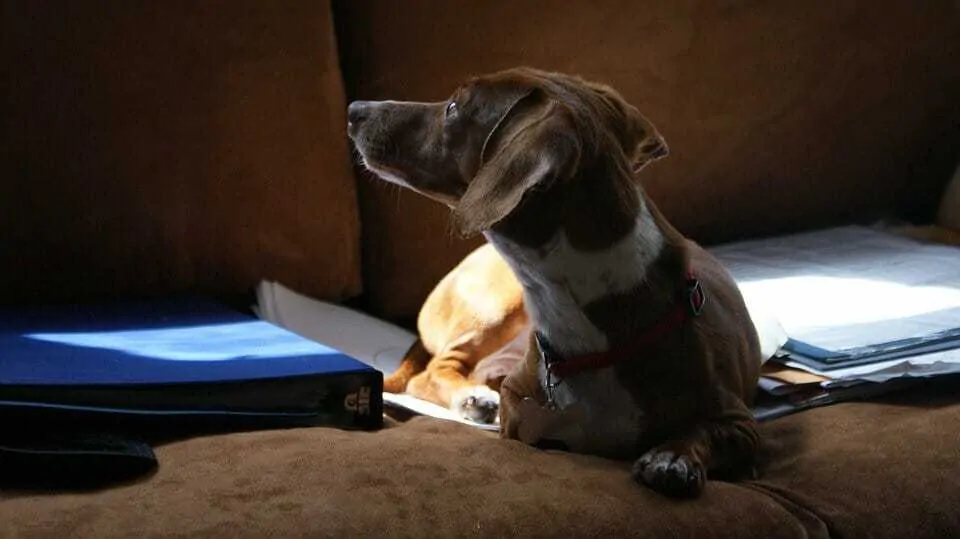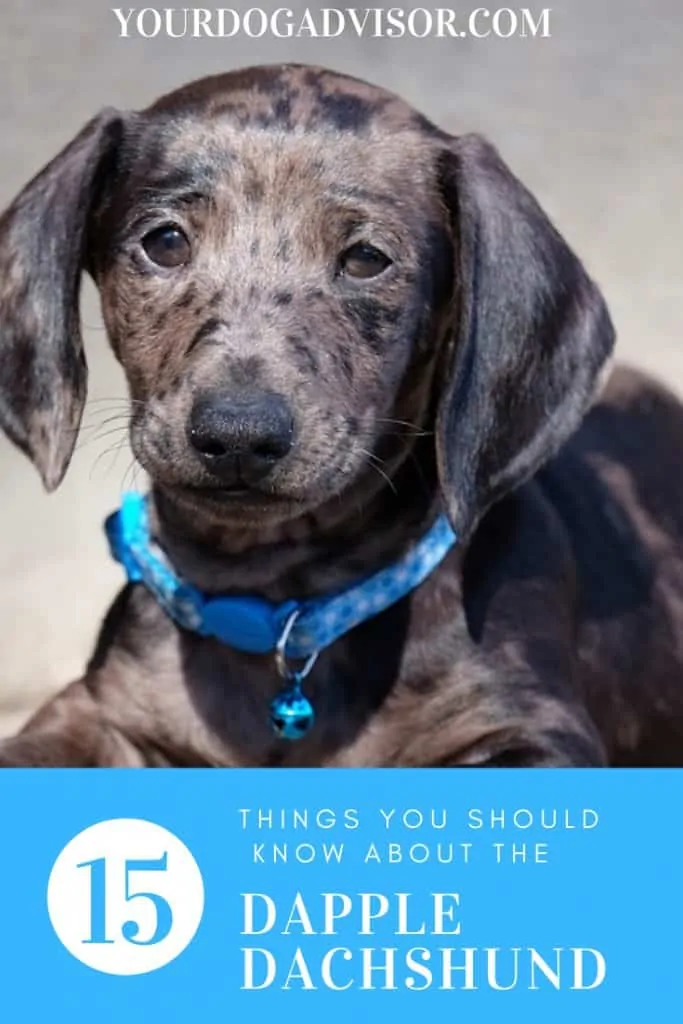The Dapple Dachshund is a Dachshund dog who has a particular pattern of spotting on its coat. Also known as the Sausage Dog, the Dapple Dachshund can be found in two sizes (standard or miniature), three coat types (smooth coated, long haired or wire-haired), and a variety of coat colors including black and tan, black and cream, chocolate, chocolate and tan, and more. The pattern of spotting is also known as dapple or merle.
What is it that we love so much about animals with spots? Perhaps it is the idea that these creatures are exotic, special, or unique even?
Whatever it is that we humans love about spots, one thing is for sure. We love them. Perhaps this is one of the reasons why Dapple Dachshund dogs are growing so quickly in popularity.
Dachshunds on their own are a thing of spectacular singularity. After all, there is nothing quite like a “sausage dog”. You know a Dachshund when you see one, with his squat little legs, his long body, his pointed muzzle, and long ears.
These endearing cuties with big personalities have a fascinating history and origin regardless of coat color, type, or pattern, but add that the Dapple Dachshund is, in many breeders’ opinions, rare to boot, and you have yourself a singular gem.
Of course, there are pros and cons to owning a Dapple Dachshund, and there are a number of things a prospective owner should know about this dog with a unique coat pattern before committing to raising one.
Are you thinking about perhaps bringing a Dapple Dachshund into your life? Before you do, here are 15 things you should know about the Dapple Dachshund dog.
Contents
1. The Dapple Dachshund Is Not A Color Of Dachshund But Is Instead A Coat Pattern
Dapple Dachshunds can come in many different colors.
There can be some confusion around what exactly a Dapple Dachshund is, and even more confusion is added when you are dealing with a dog that comes in as many varieties, colors, and coat types as the Dachshund breed does.
With that being said, the Dapple Dachshund is not a Dachshund color, per say, but a Dachshund coat pattern.
Also known as merle, the word “dapple” is used to describe the pattern of spotting on a Dachshunds coat. This means that Dapple Dachshunds can come in a variety of colors including:
- Black and tan dapple
- Black and cream dapple
- Blue and cream dapple
- Chocolate dapple
- Chocolate and tan dapple
- Silver dapple
- Red dapple
- Wild boar dapple
- Black and tan brindle dapple
- Blue and tan piebald dapple
Few! That’s a lot of variety when it comes to color, but the variety doesn’t end there with the Dapple Dachshund. Keep reading to find out why!
2. The Dapple Dachshund Comes In Two Size Varieties And Three Coat Types
Dapple Dachshunds can come in different colors, coat types, and sizes!
The Dachshund is a dog of many names. Some call him the Doxie, while others know him as the Weiner Dog. Sausage Dog is also another popular moniker for the Dachshund breed.
Along with different names and colors, did you know that Dachshund dogs also come in three different coat types as well as two different sizes?
Crazy, right? But it’s true. These distinctive dogs could be chameleons of the canine kingdom if it wasn’t for that one of a kind physique that gives them away.
One of the great things about the versatility of a Dachshund is that families and potential owners of a Dachshund breed have the luxury of choosing the dog of their dreams by having the option to choose their desired dog’s size, color, and coat type!
So, just what are your choices? As we mentioned above Dapple Dachshunds come in two different sizes:
Standard Dapple Dachshund Size
Height: 8 – 9 Inches Tall
Weight: 16 – 32 Pounds
Miniature Dapple Dachshund Size
Height: 5 – 7 Inches Tall
Weight: 8 – 11 Pounds
Regardless of their size, weight, or color, Dapple Dachshunds can come in three different coat types including:
- Smooth coat
- Longhaired
- Wirehaired
Smooth coated Dapple Dachshunds have short, sleek coats that shed moderately.
Long Haired Dapple Dachshunds have silky, wavy hair with fur that feathers at their ears and legs. Their coat also sheds moderately.
Wirehaired Dapple Dachshunds are double coated with a soft undercoat and harsh outer coat. Their hair is longer and gives them a unique look. Wirehaired Dachshunds also shed moderately.
3. Dachshunds In General Are Originally From Germany And Were Bred For Hunting Badgers
Dachshunds are bred to be courageous and tenacious hunters.
Dapple Dachshunds have huge personalities in spite of their small size and it’s no wonder, when you consider where they originally come from and what they were once bred to do.
Bred in Germany primarily for hunting, the Dachshund breed is known to be a fearless, tenacious chase and catch dog. One of the Dachshund’s most formidable foes was the ferocious and aggressive Badger.
In fact, the name Dachshund itself actually means “badger dog” in German.
The Dachshund is quite an old breed with historians tracing his origin back to the 15th century. However, most experts agree that this fierce yet devoted “badger dog” was perfected during the 17th century.
Unlike many breeds, who were bred down in size for vanity purposes, the Dachshund was specifically bred from the start to be two different sizes.
Standard Dachshund dogs carried the badge of honor (pun intended) for sniffing down badgers and flushing them from their burrows. The Miniature Dachshund, on the other hand, was bred mostly for hunting rabbits.
Dachshunds of both size varieties are still used today in the United States for hunting, and their prey includes rabbits, prairie dogs, and even includes some deer tracking.
4. Dapple Dachshunds Have Chondrodysplasia, Which Is A Form Of Dwarfism And Is Responsible For Their Unique Build.
Have you ever wondered why a Dapple Dachshund looks so unique? It’s all in his genetics!
Dachshunds were specifically built for burrowing and catching small animals, and the gene responsible for their short legs and distinctive body type is the same gene responsible for dwarfism. This gene is called Chondrodysplasia, but is also referred to as canine dwarfism.
There is some controversy amongst breeders and experts alike in the continued purposeful breeding of dogs with chondrodysplasia as it can lead to some serious health concerns, spinal issues, and chronic pain for dogs with the gene.
With that being said, the Dachshund isn’t the only breed purposefully bred with this genetic mutation. Some of the other dog breeds who carry the Chondrodysplasia gene include:
- Beagles
- Basset Hounds
- Pembroke Welsh Corgis
- The Australian Terrier
- The Dandle Dinmont Terrier
- The Highland White Terrier
- The Norfolk Terrier
- The Sealyham Terrier
- And the Cesky Terrier
But canine dwarfism isn’t the only cause for concern when it comes to the health of the Dapple Dachshund. The fact that the Dapple Dachshund has a dapple coat could put him at more risk as well.
Keep reading.
5. Dapple Dachshund Dogs Can Be Prone To More Health Issues Than Their Other Dachshund Counterparts
The merle gene that makes the Dapple Doxie’s coat dapple is also responsible for higher instances of deafness, blindness, sensitivity to sunlight, and higher rates of skin cancer in the dog breeds that carry it.
A Dapple Dachshund becomes even more at risk of suffering serious health concerns when he is a double dapple, meaning both his parents carry and have passed on the merle gene to him. Double Dapple Dachshund dogs (say that three times fast) can be born deaf, blind, or even born without eyes.
The good news is that, for the most part, single Dapple Dachshunds are much less likely to have these serious health concerns and are often born as healthy as other Dachshund pups.
With that being said, like all dogs, Dapple Dachshunds can be susceptible to a number of the same genetic issues that any type of Dachshund dog is susceptible to.
Some of the most prevalent genetic health issues seen in Dachshund dogs include:
- Back and spinal issues and pain
- Intervertebral disk disease
- Mast cell tumors
- Squamous Cell Carcinoma
- Seizures and Epilepsy
- Obesity
- Patellar luxation
- Osteogenesis imperfecta
- Granulomatous meningoencephalitis
- Dental issues
- Thyroid
- Cushing’s syndrome
- Allergies
- Autoimmune issues
- Cataracts
- Prgressive retinal atrophy, corneal ulcers
- Cherry eye
- Patent ductus arteriosus (congenital heart defects)
- And skin disorders resulting in hair loss
It is a long list we know but the good news is that, with proper care, diet, and exercise, most Dapple Dachshunds live a long and healthy life. In fact, Dapple Dachshunds are even said to have a nice, long life expectancy of 12 – 16 years!
6. Though Small, Dapple Dachshunds Have Big Personalities And Will Keep You Laughing!
Dapple Dachshunds are known for being tiny, sausage-shaped comedians.
Just like their wild, crazy nicknames, Dapple Dachshunds and Dachshunds in general are known for their over the top personalities. They are larger than life and nothing but tiny, sausage-shaped comedians.
Dachshunds love themselves some Dachshund, and they also love themselves. They don’t need to be the same species to communicate to us just how awesome they think they are.
On that note, Dachshunds are also very insistent about the things they want and need. Are you not giving your Dapple Dachshund enough attention? He’ll climb right up onto your lap and let you know.
Is it five minutes past dinner time? Oh, you’ll know your Doxie is hungry. Trust us. In fact, many Doxie owners will tell you that they didn’t train their Dachshund – their Dachshund trained them.
And perhaps most adorably, Dachshunds constantly look like they are still growing into their ears. As such, these ears will continually flap over their little heads like shawls and you’ll find yourself returning them to their original hanging position over and over again. The struggle is real.
But unfortunately, it’s not all fun and games with a Dapple Dachshund. Along with that cute, funny, and comical behavior, Doxies can also be somewhat problematic.
But just how problematic? Read below to find out.
7. Dapple Dachshunds Can Be Prone To Problematic Behaviors LIke Digging, Barking, And Stubbornness
Dapple Dachshunds like to bark and dig, which can be problematic.
Along with being cute, knowing what they want, and making you swoon with their adorable stubby legs, Dachshunds also come with a fair list of behavioral problems that are not always the easiest to train out of them.
Lovers of the Dachshund breed agree that these pups like to use their voice. They are vocal dogs who bark and bark loudly despite their small size.
They can also exhibit aggressive behaviors and be territorial, especially if not properly socialized and trained at an early age.
And, due to their long history as hunting dogs, Doxies tend to have a high prey drive. This means they should be taught a solid and reliable recall as early as possible and walked safely with a leash and harness when out and about.
Backyards should be securely fenced with fences that go well underground, because, along with barking and running, Dachshunds like to dig.
We can blame this on their origin of hunting badgers and digging them out of their burrows. In fact, the Dachshunds body was actually designed for digging and burrowing.
Their long spines are flexible and their front paws are crooked and shaped like paddles, making Dachshunds perfect little digging machines.
This can be a problem for your beautiful lawn, your freshly planted rose bush, or even your newly made bed. Because inside or outside, dirt, sand, or pillows, Dachshunds like to burrow.
And while Dachshunds are highly food-motivated, they cannot be bought. These hard headed hounds won’t do anything they don’t want to do, and it’s tough to bribe them. Still, if you think like a Dachshund and try to make training fun, game-like, and interesting, your Dachshund should enjoy learning and make for a good student.
On the flip side of this, Doxies can be sensitive and easily have hurt feelings. They will shut down if trained too harshly so experts recommend sticking with positive reinforcement methods like consistency, treats, and praise.
8. Dapple Dachshunds Only Need One Spot On Their Coat To Be Considered Dapple
Your Dapple Dachshund doesn’t need to be entirely spotted to be considered a dapple dog.
How do you know if a Dapple Dachshund is a Dapple Dachshund? By the spots, of course! However, you may be surprised to learn that a Dapple Doxie only needs one spot somewhere on his body to be considered a Dapple Dachshund.
For instance, the Doxie above who is mostly black and tan has a splash of spotting on his chest. So, while he may not match your idea of what a typical Dapple Dachshund looks like, by definition, he is a Dapple Dachshund.
9. Dapple Dachshunds Become Very Bonded With Their People
Dachshunds are loyal, devoted dogs who can be prone to separation anxiety.
All Doxies, not just the Dapple Dachshund, are known for their incredible devotion to their family members. This is, perhaps, one of their most beloved traits, although it can sometimes contribute to their behavioral issues and destructive behaviors.
This is because Dachshunds tend to become very bonded with their families and don’t do well if left home alone for extended periods of time.
Dapple Dachshunds need lots of love and attention and will want to be with you wherever you go. If they get bored or lonely, they tend to become depressed and destructive. They may also suffer from separation anxiety, which can lead to destructive behaviors you don’t normally see when you are home.
Are you wondering if you have a Dachshund with separation anxiety? Dogs with separation anxiety tend to scratch or chew mostly at doors or windows, as these are routes of escape, or they will turn to chewing furniture, ripping up toys, or destroying clothing or shoes, but only while their family is away.
When family is home, the dog is fine.
There are a few ways you can go about dealing with a dog who suffers from serious separation anxiety, like the Dapple Dachshund. You can work to properly crate train your Dapple Dachshund so he and your home stay safe while you are gone.
Some owners also opt to hire pet care services like professional dog walkers to come in and give their Doxie some exercise and love to help break the day up for them.
However, one of the best ways to help keep a Dapple Dachshund happy while you are gone is to ensure he has another Doxie playmate. Dapple Dachshunds love having a doggy counterpart to play with and get along especially well with other sausage dogs. How cute is that?
10. Dapple Dachshunds And Their Other Dachshund Counterparts Are The Smallest Of The Hound Types
The Dapple Dachshund is small but mighty!
You probably already knew that the Dapple Dachshund is small, but did you know this is the smallest dog of the hound types?
That’s right!
Dachshund dogs are tiny but tough, and bred purposefully this way! Based on what we’ve already learned about the Dachshund’s history, it’s clear that there were no accidents when it came to the physical appearance of this unique looking breed.
Everything from their size to their physique was purposeful, making them ideal burrowing dogs with clever minds, brave hearts, and long, flexible little bodies.
11. When Properly Trained And Socialized, Dapple Dachshunds Can Get Along Well With Children And Pets
Dapple Dachshunds make great companions, but is this the right dog for you?
Dapple Dachshunds make great companions for the right home or owner, but is this the right dog for families with children and other household pets?
While Dachshunds do get along well with other dogs and especially other Doxie dogs, they may not do well with smaller pets like rodents, birds, and reptiles. This is mostly due to the Dachshunds high prey drive and history as a hunting hound.
With that being said, Dapple Dachshunds can get along well with cats and they can even make good companions for families with children, although they will need to be properly trained and socialized at an early age.
Because of their hunting history and tendencies to be territorial, experts suggest making sure Dachshunds are adequately socialized in a number of different situations to help them grow up happy and healthy.
And of course, don’t leave small children unsupervised with your Dapple Dachshund, as any dog can be susceptible to biting or nipping when in fear or if they are in pain.
We also suggest that parents work with children on the proper and appropriate ways to interact with dogs to ensure that playtime is safe and fun for everyone involved.
12. Dapple Dachshunds Are Super Smart Working Dogs And Need Lots Of Training, Time, And Attention From Owners
Dapple Doxies may surprise you with the amount of exercise and attention they need from you.
Like all intelligent working dog breeds, the Dapple Dachshund is going to need a little extra time and attention from a patient, devoted owner.
Dachshunds in general need moderate exercise each and every day. Brisk walks through the neighborhood as well as a fun game of fetch or chase in the yard will help to keep them feeling their best, while brain games and puzzle toys will help keep their active and intelligent minds satisfied.
Dapple Dachshunds do great with active families who enjoy being outside and will love taking part in fun activities. When they are younger and in good shape, there is very little that Dachshunds cannot do.
Proper exercise is especially important for dogs like Dachshunds who have shorter legs and longer bodies, as keeping them at a healthy body weight will help to reduce the instances of spinal problems.
Remember, Dachshunds can be especially prone to obesity, which can lead to a number of health concerns, so make sure your Dachshund is adequately exercised.
You should also remember that Dapple Dachshunds can be prone to destructive behaviors which can be made worse by boredom, so keeping your Dachshund dog mentally stimulated will help reduce unwanted behaviors in the breed as well.
13. As Dapple Dachshunds Age, They Will Need Help Getting Up And Down From Furniture and Stairs
The Dapple Dachshund’s back will eventually cause mobility issues.
While we may love the Dapple Dachshunds stubby legs and long back, we should keep in mind that this unique build will, eventually, lead to some mobility issues as the Dachshund ages.
You can help alleviate any pain or injury to your Dapple Dachshund by keeping him adequately exercised, making sure he is on a healthy diet for his age, weight, and activity level, and by providing ramps throughout your home so he has easy access to all of his favorite places like onto the couch or bed.
Offering your Dapple Dachshund climbing ramps is a great way to dog proof your home for your Doxie, especially as he enters into his senior years.
14. Dapple Dachshund Puppies Tend To Cost More Than Other Types Of Dachshund Dogs When Bought From Breeders
Do you want a Dapple Dachshund puppy? Then get ready to spend a little more money.
Many breeders consider Dapple Dachshunds to be rare, and Dapple Dachshunds need to be bred carefully by responsible breeders to ensure they are healthy and don’t carry the double dose of the merle gene.
Purposefully breeding a healthy a Dapple Dachshund takes an experienced breeder and can take a few generations of breeding to get right.
So, just how much will a Dapple Dachshund cost you? Most people find that they spend anywhere from $400 to over $1,100 for a Dachshund in general, with Dapple Dachshunds being on the more expensive end of the spectrum.
Are you on a budget? Be careful of trying to cut costs by going through backyard breeders, online sellers, or pet stores to get your hands on a Dapple Dachshund. Remember, just because the price may be lower on the front end doesn’t mean you won’t end up paying more on the back end.
A sick puppy could wind up costing you thousands of dollars in the long run, as well as emotional distress and time.
It’s safest to go through reputable, responsible breeders when looking for a Dapple Dachshund. Responsible breeders will have had their puppies health screened and will be able to offer you certificates of health proving their dogs are cleared of any serious health concerns before going home with you.
If you really want a Dapple Dachshund but have your heart set on adoption, don’t count yourself out!
The Dachshund breed as a whole requires a special owner who is equipped to handle their unique needs, which unfortunately means that it is not uncommon for Dachshunds, both dapple and not, to wind up in shelters and rescue centers and in need of a good home.
Best of all, many states around the country offer breed-specific rescues and it may not be as difficult as you think to find the Dapple Dachshund of your dreams through a shelter for a fraction of the price of going through a breeder!
Sounds like a win-win to me.
15. The Dapple Dachshund Is Adaptable To Different Living Environments As Long As His Exercise Needs Are Met
Dapple Dachshunds can make good apartment dogs so long as they are properly exercised. But I want you to notice that I said “can make good apartment dogs”, not “do make great apartment dogs”.
Remember, Dachshunds as a breed tend to bark, dig, and burrow, which could spell disaster on your rental.
This is a breed who has the potential to do well in an apartment as long as his exercise needs are being met, he is adequately trained, and you are going to be around often enough to keep him from getting too bored or becoming anxious.
With that being said, because they come in two different sizes and require only moderate exercise, Dapple Dachshunds can be adaptable to both apartment and home type living situations.
And while Dapple Dachshunds do enjoy playing outside, they are meant to be indoor dogs who won’t do well living outside in the backyard dog house. Not only could this be dangerous for your Doxie, but it would also be cruel as Dachshunds become so bonded with their families.
But trust us, once you get to know a Doxie, you won’t want to be away from him!
So, do you think the Dapple Dachshund is the right dog for you and your home? Tell us your opinion on the Dapple Dachshund in the comment section below!

Jen Jones is a professional dog trainer and behavior specialist with more than 25 years of experience. As the founder of ‘Your Dog Advisor’ and the ‘Canine Connection’ rehabilitation center, she applies a holistic, empathetic approach, aiming to address root causes rather than merely treating symptoms.
Well known for her intuitive and compassionate approach, Jen adopts scientifically-proven, reward-based methods, encouraging positive reinforcement over punishment. Jen specializes in obedience training, behavior modification, and puppy socialization. Her innovative methods, particularly in addressing anxiety and aggression issues, have been widely recognized. Jen has worked with many of the world’s leading dog behaviorists and in her free time volunteers with local animal shelters and rescue groups.
